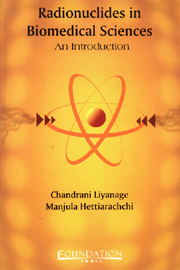Book contents
- Frontmatter
- Contents
- Forewords
- Introduction
- 1 Atomic and Nuclear Structure
- 2 Radiation Detectors
- 3 Units of Radiation Measurements
- 4 Iodine–125
- 5 Radioimmunoassay
- 6 Quality Control in RIA
- 7 Radiolabelled Compounds
- 8 Radiation Safety
- 9 Radiation Protection
- 10 Background Radiation
- 11 Storage
- 12 Contamination
- 13 Radioactive Waste
- References
2 - Radiation Detectors
Published online by Cambridge University Press: 26 October 2011
- Frontmatter
- Contents
- Forewords
- Introduction
- 1 Atomic and Nuclear Structure
- 2 Radiation Detectors
- 3 Units of Radiation Measurements
- 4 Iodine–125
- 5 Radioimmunoassay
- 6 Quality Control in RIA
- 7 Radiolabelled Compounds
- 8 Radiation Safety
- 9 Radiation Protection
- 10 Background Radiation
- 11 Storage
- 12 Contamination
- 13 Radioactive Waste
- References
Summary
Detectors presently used in radiation spectrometry (pulse-height analysis) are semiconductor detectors, either germanium or silicone. This type includes:
a. Surface barrier detectors for charged particles
b. Partially or totally depleted detectors
c. Lithium drifted detectors
d. High purity germanium (HPGe) detectors.
These detectors have very high order of energy resolution. Since the energy required for producing an ion-electron pair is at least 20 times less than a gas detector, a large number of such pairs is produced resulting in much better statistics and better resolution of energy. The efficiency, however, is lower than a sodium iodide crystal due to lower Z of germanium and silicon.
COUNTING ELECTRONICS
All counting systems for gamma-radiation measurement in vitro are based on scintillation detectors embodying a thallium-activated sodium iodide (Nal(TI)) crystal. A Nal(TI) crystal with either an axial well or transverse hole may be used. When the sample vial is lowered into the well or positioned in the hole, the gamma rays are absorbed or scattered in the crystal. These rays cause light scintillations, which in turn give rise to electrical pulses at the photo 12 Radionuclides in Biomedical Sciences cathode of the photo multiplier to which the crystal is optically coupled. These pulses are amplified by the photo multiplier and the amplified pulses appearing at the final anode are fed to the associated electronics for further amplification, pulse-height analysis and counting.
The gamma radiation interacts with matter in diverse processes. As such, the scintillations emitted in the crystal vary in intensity and the resulting electrical pulses vary correspondingly in height.
- Type
- Chapter
- Information
- Radionuclides in Biomedical SciencesAn Introduction, pp. 11 - 13Publisher: Foundation BooksPrint publication year: 2008



